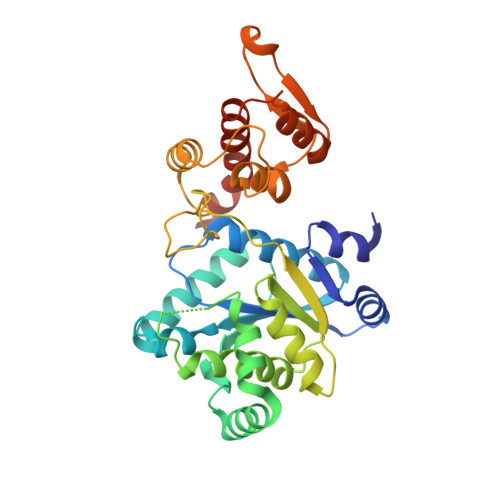Structural Basis of Improved Second-Generation 3-Nitro-tyrosine tRNA Synthetases.
Cooley, R.B., Feldman, J.L., Driggers, C.M., Bundy, T.A., Stokes, A.L., Karplus, P.A., Mehl, R.A.(2014) Biochemistry 53: 1916-1924
- PubMed: 24611875
- DOI: https://doi.org/10.1021/bi5001239
- Primary Citation of Related Structures:
4ND6, 4ND7, 4NDA - PubMed Abstract:
Genetic code expansion has provided the ability to site-specifically incorporate a multitude of noncanonical amino acids (ncAAs) into proteins for a wide variety of applications, but low ncAA incorporation efficiency can hamper the utility of this powerful technology. When investigating proteins containing the post-translational modification 3-nitro-tyrosine (nitroTyr), we developed second-generation amino-acyl tRNA synthetases (RS) that incorporate nitroTyr at efficiencies roughly an order of magnitude greater than those previously reported and that advanced our ability to elucidate the role of elevated cellular nitroTyr levels in human disease (e.g., Franco, M. et al. Proc. Natl. Acad. Sci. U.S.A 2013 , 110 , E1102 ). Here, we explore the origins of the improvement achieved in these second-generation RSs. Crystal structures of the most efficient of these synthetases reveal the molecular basis for the enhanced efficiencies observed in the second-generation nitroTyr-RSs. Although Tyr is not detectably incorporated into proteins when expression media is supplemented with 1 mM nitroTyr, a major difference between the first- and second-generation RSs is that the second-generation RSs have an active site more compatible with Tyr binding. This feature of the second-generation nitroTyr-RSs appears to be the result of using less stringent criteria when selecting from a library of mutants. The observation that a different selection strategy performed on the same library of mutants produced nitroTyr-RSs with dramatically improved efficiencies suggests the optimization of established selection protocols could lead to notable improvements in ncAA-RS efficiencies and thus the overall utility of this technology.
Organizational Affiliation:
Department of Biochemistry and Biophysics, Oregon State University , 2011 Agriculture and Life Sciences Building, Corvallis, Oregon 97331, United States.















